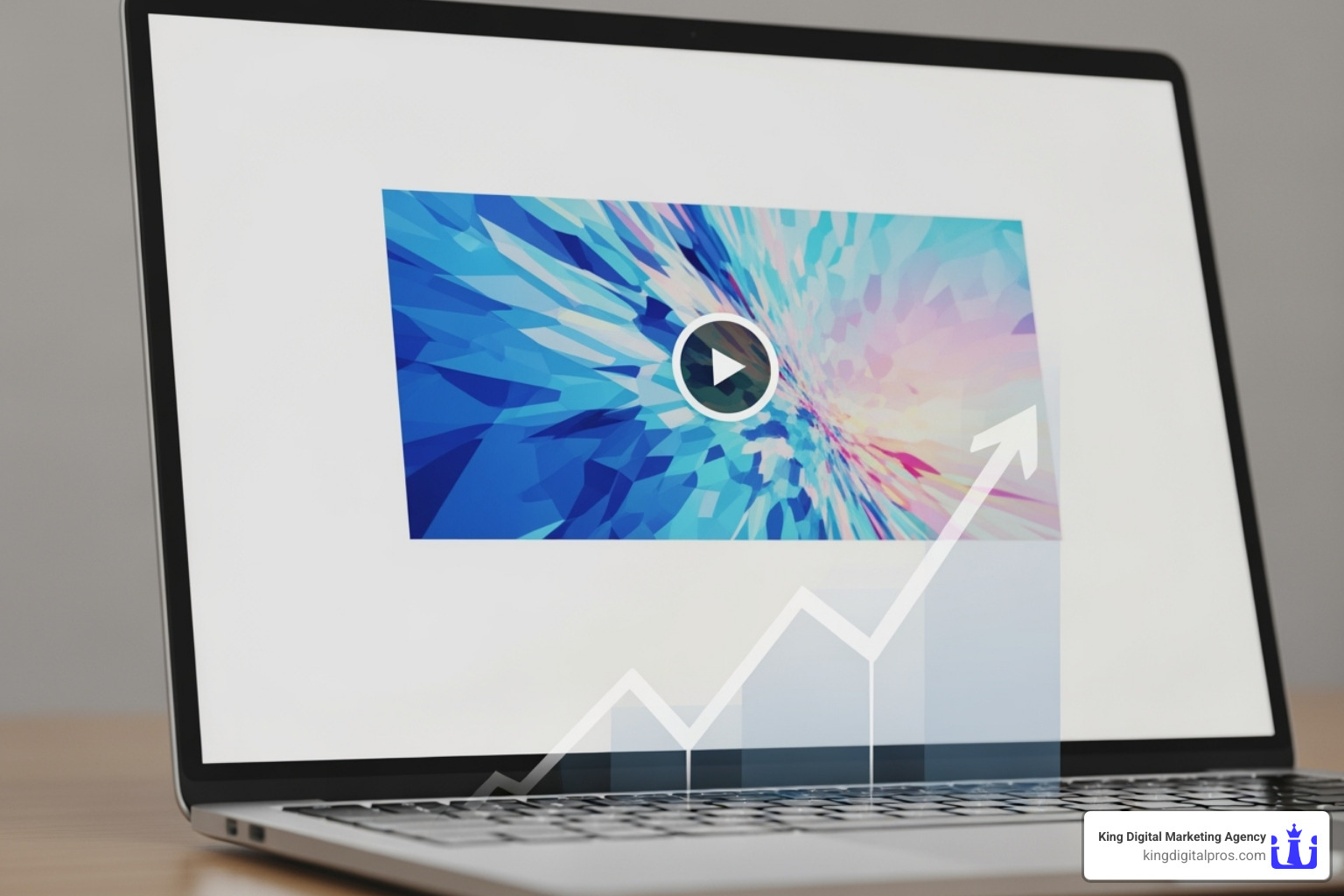Why YouTube SEO is the Key to Getting Your Videos Seen
To rank your videos on YouTube, you must treat it as the world’s second-largest search engine. With billions of monthly searches and immense competition, visibility depends on effective YouTube Search Engine Optimization (SEO). The algorithm evaluates two main signal groups: technical elements (titles, descriptions, tags) that define your video’s topic, and human engagement signals (watch time, clicks, comments) that prove its value to viewers.
Many businesses produce high-quality videos that fail to get views because they neglect the fundamental SEO steps that help YouTube categorize and recommend their content. This guide outlines the proven optimization techniques we use to achieve consistent results for our clients.
Focus on these core strategies:
- Keyword Research: Find what your audience is searching for before you film.
- Metadata Optimization: Craft compelling titles, descriptions, and tags using your target keywords.
- High-Retention Content: Create videos with a strong hook that keep viewers watching.
- Custom Thumbnails: Design eye-catching thumbnails that accurately represent your content.
- Audience Engagement: Encourage likes, comments, and subscriptions to signal value.
- Strategic Promotion: Drive initial views through email, social media, and other channels.
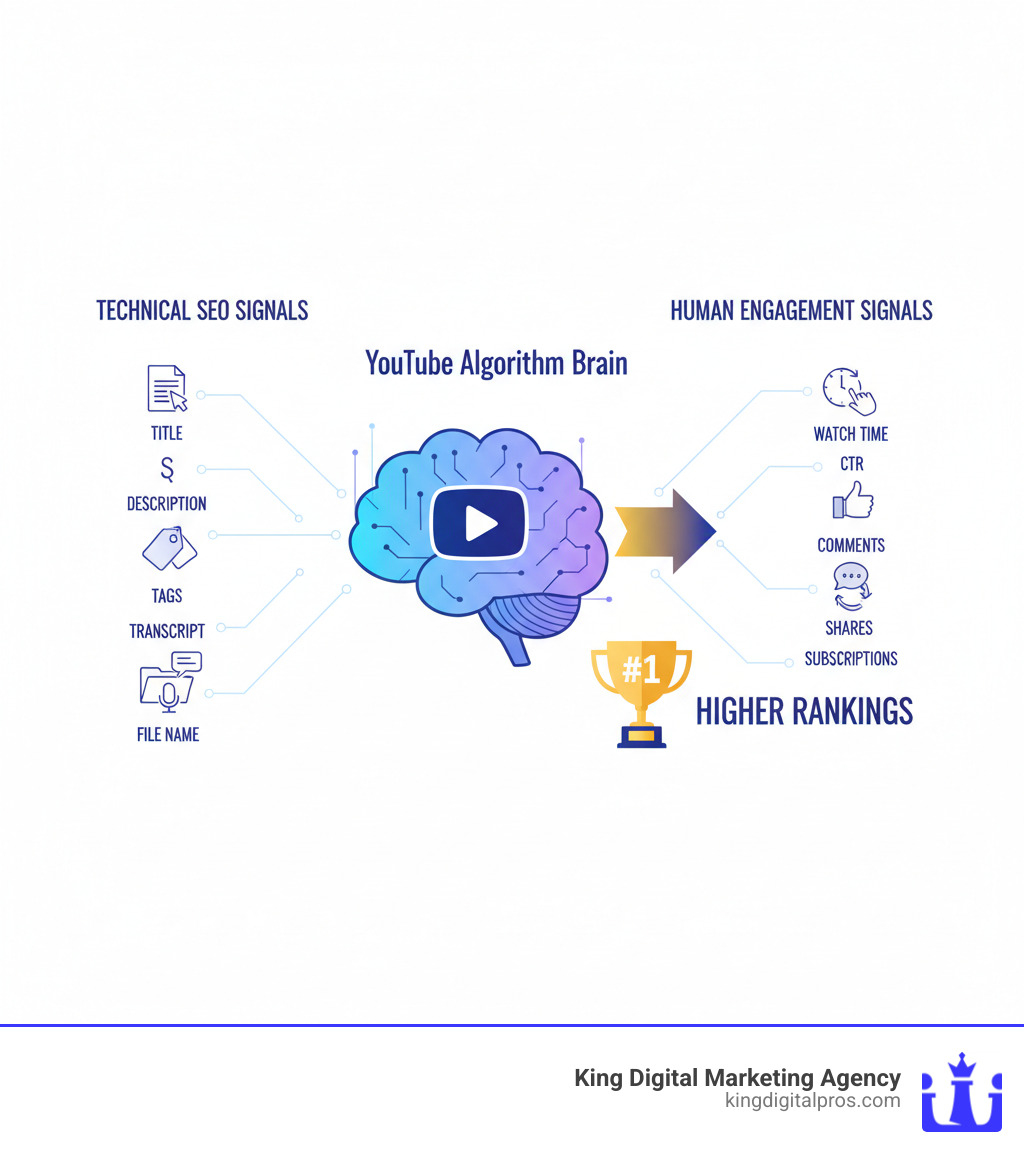
Foundational SEO: Keyword Research and Content Planning
Success on YouTube begins before you press record. The most critical first step is understanding what your audience is searching for. Keyword research is the foundation of a successful video strategy, allowing you to create content that meets existing demand. Focus on the search intent behind queries and target long-tail keywords – specific phrases of three or more words that have decent search volume but lower competition.
Conducting Keyword Research
Finding the right keywords involves a few key tactics:
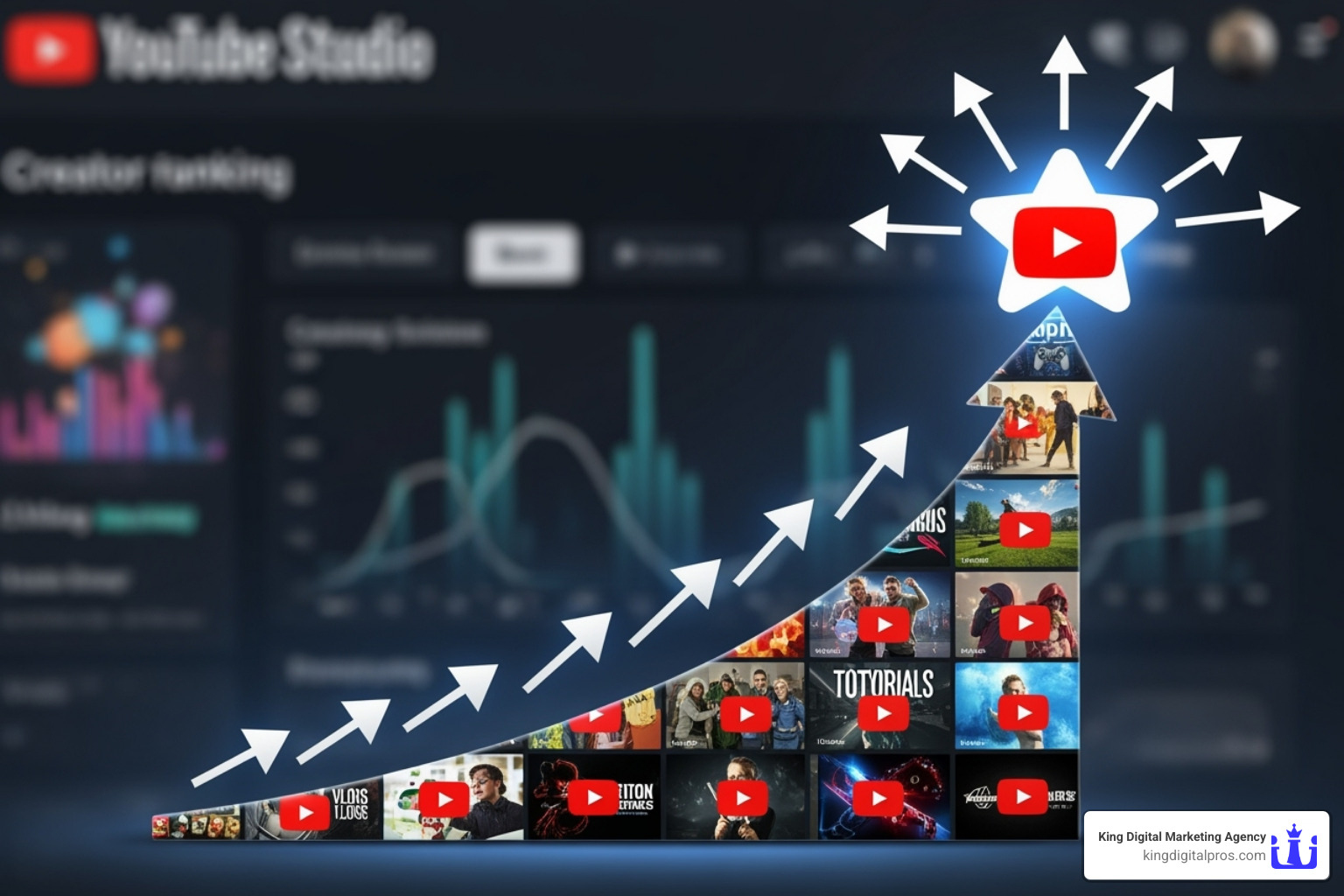
- YouTube Autocomplete: Start typing a topic into the YouTube search bar. The suggestions that appear are popular, real-world search queries, often revealing valuable long-tail opportunities.
- Specialized Tools: Browser extensions like TubeBuddy and VidIQ provide estimated search volume and competition data directly on YouTube. Other powerful tools like Ahrefs and SEMrush offer deep insights into search trends. Aim for keywords with a good balance of search volume and manageable competition.
- Competitor Analysis: Analyze top-ranking videos in your niche. Use tools to see the keywords and tags they use to learn from their success and identify content gaps you can fill.
- Google Search: If Google features video results for a specific query, it’s a strong indicator that users prefer video content for that topic, making it a prime keyword for your YouTube strategy. This foundational work is crucial to Improve Search Ranking across all platforms.
Planning High-Retention Video Content
Once you have your keywords, create content that keeps viewers watching. The YouTube algorithm heavily favors watch time and audience retention.
- Hook Viewers Immediately: The first 15-30 seconds are critical. A 2015 AdAge study highlighted the need to capture attention within the first ten seconds. Start with a compelling question, a surprising fact, or a preview of the video’s value.
- Use a Script or Outline: A structured script ensures clarity and helps you naturally include your target keyword 2-3 times. YouTube’s automated transcription uses spoken words as an SEO signal.
- Determine the Right Video Length: Longer videos tend to rank better because they accumulate more total watch time. However, this only works if the content is engaging. The ideal length depends on the topic; a quick tip may need 3 minutes, while an in-depth tutorial could be 15 minutes. Focus on delivering comprehensive value without filler.
How to Rank Your Videos on YouTube: A Step-by-Step Optimization Guide
After planning your content, the next step is to optimize every technical element to help YouTube understand and rank your video. This process involves crafting your metadata and using platform features to signal relevance. As a study of 1.3 million YouTube videos by Backlinko found, on-page optimization and engagement are deeply connected.
Crafting Clickable Titles and Descriptions
Your title and description must appeal to both the algorithm and human viewers.
- Title: Place your primary keyword at the beginning of a compelling title. Keep it under 70 characters (6-10 words) to avoid truncation in search results. Use numbers or action words to increase clicks, but ensure the title accurately reflects the content.
- Description: Put your primary keyword within the first 25 words. Write a detailed, 200-350 word description that naturally incorporates your keyword 2-4 times. Include clear calls-to-action (CTAs) and a few branded links to your website or other relevant videos.
Designing Compelling Thumbnails
Your thumbnail is often the deciding factor for a click. Always create a custom thumbnail with these best practices in mind:
- Resolution: Use a high-quality 1280×720 pixel image.
- Clarity: Use high-contrast colors, simple graphics, and large, minimal text to ensure it’s readable at any size.
- Composition: Feature expressive human faces and use the rule of thirds to create a dynamic look.
- Consistency: Maintain a consistent brand style across your thumbnails to build channel recognition.
- Honesty: Avoid clickbait. A misleading thumbnail leads to poor audience retention, which hurts your ranking.
Using Tags, Captions, and Timestamps
These features provide additional context and improve user experience.
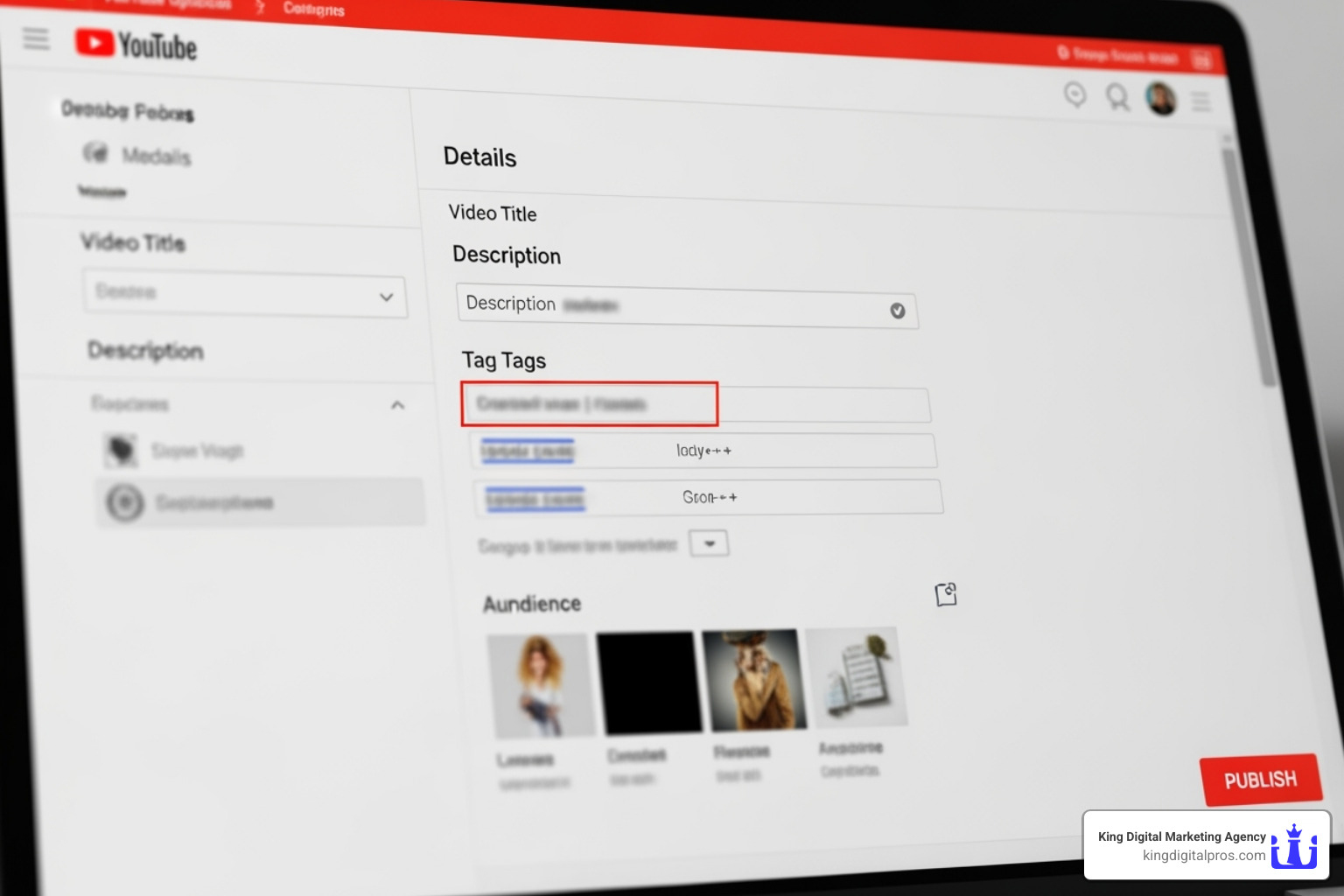
- Tags: While not a major ranking factor, tags help YouTube categorize your content and appear in suggested videos. Use 8-12 relevant tags, including your target keyword and variations.
- Closed Captions (CC): Captions make your content accessible to a wider audience, including the nearly 20% of the global population with hearing loss. More importantly for SEO, captions are crawlable text that helps YouTube and Google understand your video’s content. Always edit the auto-generated captions for accuracy.
- Timestamps (Video Chapters): For longer videos, timestamps break your content into navigable sections. This improves user experience and engagement by helping viewers find the exact information they need.
Common YouTube SEO Mistakes to Avoid
- Keyword Stuffing: Forcing keywords unnaturally into your metadata looks spammy and is penalized.
- Misleading Titles/Thumbnails: Clickbait leads to high bounce rates and low watch time, signaling poor quality to the algorithm.
- Ignoring Analytics: Regularly review your YouTube Studio data to understand what works and where to improve.
- Inconsistent Publishing: Stick to a regular schedule to keep your audience engaged and signal to YouTube that your channel is active.
- Neglecting Promotion: An initial promotional push is crucial for gaining momentum.
- Poor Audio/Video Quality: Bad audio, in particular, will cause viewers to leave quickly. Invest in a decent external microphone.
Boosting Your Signal: Engagement, Watch Time, and Promotion
Technical optimization gets your video indexed, but human engagement signals tell YouTube it’s worth watching. The algorithm’s primary goal is to keep users on the platform, so it rewards videos that people enjoy. Key metrics like watch time (how long people watch) and session time (how long they stay on YouTube after your video) are critical ranking factors. Improving these metrics is as vital as improving your website’s Digital Marketing Conversion Rate.
Maximizing Watch Time and Audience Engagement
Use these tactics to encourage the signals YouTube values most:
- Ask for Engagement: Directly ask viewers to like, comment, and subscribe. Comments are a particularly strong ranking signal.
- Foster Community: Pin a question as a top comment to spark discussion and respond to comments within 24-48 hours to show you’re an active creator.
- Use Interactive Features: Implement cards (pop-up notifications) to link to related content during your video. Use end screens in the final 5-20 seconds to promote other videos, playlists, or a subscribe button.
- Create Playlists: Group related videos into keyword-optimized playlists. They autoplay, which significantly increases total watch time and session duration. Playlists can also rank in search results themselves.
Promotion Strategies to Gain Momentum
Even a perfectly optimized video needs an initial push. Promotion creates a positive feedback loop: initial views generate engagement signals, which encourages YouTube to recommend your video to a wider audience.
- Email List: Notify your subscribers when a new video is published. This is a highly engaged audience that can provide a strong initial viewership boost.
- Social Media: Share your video across relevant platforms, tailoring the message for each one. LinkedIn is excellent for B2B content, while Twitter can drive strong engagement.
- Blog Embeds: Embed your videos in relevant articles on your website. This drives views and increases the time visitors spend on your page, which also benefits your site’s SEO.
- Collaborations: Partner with other creators in your niche to tap into their established audiences.
- Q and A Sites: Answer relevant questions on sites like Quora and link to your video as a helpful resource. This drives highly-qualified, interested viewers.
Analyzing Performance and Refining Your Strategy
To consistently rank well, you must analyze your performance and refine your strategy. This iterative process of testing and measuring is the core principle of What is Conversion Rate Optimisation?. Use YouTube Analytics to understand audience behavior and guide your content decisions.
Understanding Your YouTube Analytics
YouTube Studio provides the data you need to improve. Focus on these key reports:
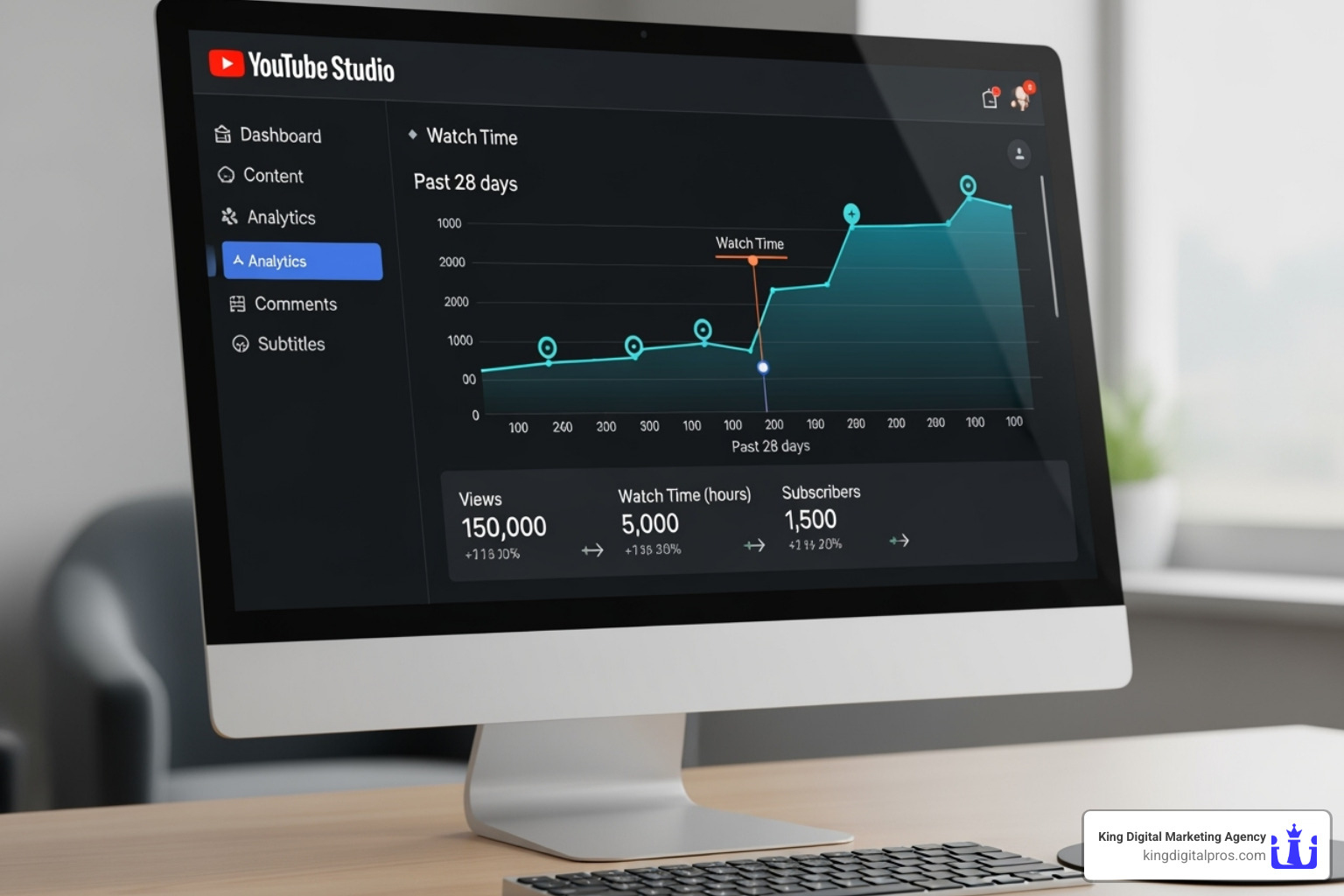
- Click-Through Rate (CTR): Measures the effectiveness of your titles and thumbnails. A low CTR indicates your packaging isn’t compelling enough.
- Audience Retention: Shows exactly when viewers drop off. Use this to identify boring segments and improve your video structure.
- Watch Time: The total minutes viewers have spent watching your content. This is a primary indicator of video quality and a key ranking factor.
- Traffic Sources: Reveals how viewers are finding your videos (e.g., YouTube Search, Suggested Videos, External). This helps you understand which findy channels are working best.
- Subscriber Reports: Shows which videos are most effective at converting viewers into subscribers.
Regularly reviewing these metrics will reveal patterns and provide invaluable insights for your future content strategy.
Comparing YouTube SEO vs. Traditional SEO
While related, YouTube SEO and traditional website SEO prioritize different factors. YouTube’s algorithm is obsessed with viewer engagement and watch time, while Google’s algorithm for web search heavily weighs backlinks and domain authority.
| Feature | YouTube SEO | Traditional Website SEO |
|---|---|---|
| Primary Goal | Maximize watch time, audience engagement, and video findability. | Maximize organic traffic to web pages from search engines. |
| Key Ranking Factors | Watch Time, Audience Retention, CTR, Engagement, Metadata. | Backlinks, Domain Authority, Technical SEO, Content Quality. |
| Content Format | Video | Primarily text, images, and embedded media. |
| Algorithm’s Focus | Viewer behavior (do people watch and engage?). | External signals (who links to this page?). |
| Ease of Ranking | Often easier for new channels to gain traction quickly. | Challenging for new sites due to the time needed to build authority. |
A comprehensive digital strategy should leverage both, as they complement each other to maximize brand visibility.
Frequently Asked Questions about Ranking YouTube Videos
Here are concise answers to the most common questions about YouTube SEO.
How long does it take to rank a video on YouTube?
It varies. A well-optimized video on a trending topic can rank in hours, but for most content on newer channels, it can take a few weeks to several months. Ranking speed depends on keyword competition, channel authority, and especially the engagement your video receives in the first 24-48 hours. This is why initial promotion is so important.
Are YouTube tags still important for ranking?
Tags have a minimal direct impact on search ranking compared to your title, thumbnail, and watch time. However, they are still useful. According to research from Tubics, tags help YouTube categorize your content and can help your video appear in the “suggested videos” sidebar. It’s a best practice to use 8-12 relevant tags, but don’t expect them to be a magic bullet for ranking.
Does video length affect YouTube rankings?
Yes, but indirectly. Longer videos tend to rank better because they have the potential to accumulate more total watch time, a critical ranking signal. However, this only works if the video maintains high audience retention. A long, boring video that people abandon quickly will perform worse than a shorter, highly engaging one. As research from Wistia suggests, engagement is key. The ideal length is however long it takes to deliver complete value on your topic without adding filler.
Conclusion
You now have a roadmap to rank your videos on YouTube. Success hinges on combining high-quality, valuable content with smart, consistent optimization. YouTube SEO is not a one-time task but an ongoing process of creating, optimizing, promoting, and analyzing.
The core principle is simple: create videos that genuinely help or entertain your audience, and then apply the technical and engagement strategies we’ve covered to ensure the algorithm understands their value. From keyword research and metadata optimization to fostering engagement and analyzing performance, each step is crucial.
Video marketing is a powerful tool; Wyzowl’s State of Video Marketing report shows 91% of businesses used it in 2023. At King Digital Marketing Agency, we specialize in crafting digital strategies that drive results, from local Google Business Profile optimization to comprehensive YouTube SEO.
The fundamentals of understanding your audience, creating quality content, and optimizing for findy will always be the keys to success on YouTube. If you’re ready to implement a proven strategy and get your videos the visibility they deserve, we’re here to help.

